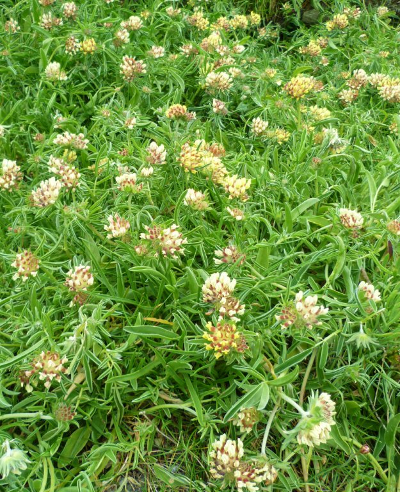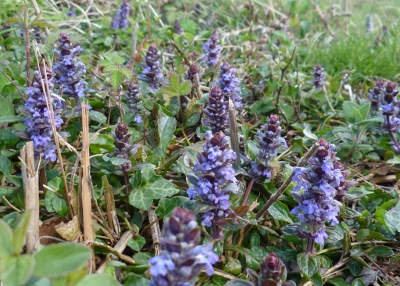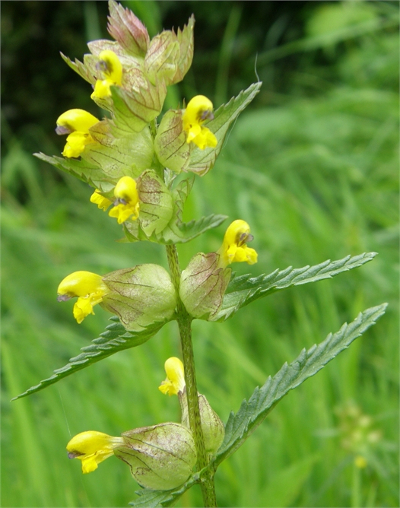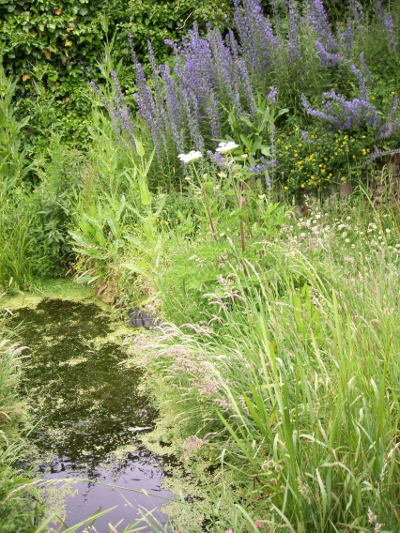

It is possible to create great short grass areas for bees suitable for you to sit or lie. The Pea family (Fabacea) in particular are very important bumblebee forage and both Birdsfoot trefoil and Red clover can create very attractive low maintenance lawn areas in a garden.
The best management for such an area is mowing and removing the clippings throughout Sept to March keeping as a short lawn. Whilst between April to Sept cutting a bit higher and leaving for a few weeks to flower and set seed either areas within the lawn or particular plants. You can time the cuts depending on the species you wish to flower and set seed. This obviously does work better if you can come to terms with a less formal lawn. In my experience the lawn in summer can be kept slightly taller than a normal lawn, which allows the plants to flower, and for you to lie on top of the flowers without damaging them.
Another way is to have a spring meadow/lawn leave it uncut between late March and June then cut as a short lawn outside these times. This works particularly well in Devon and Cornwall it also results in a lawn probably more acceptable for an obsessive gardener.

Kidney Vetch

Bugle
| Red clover | Trifolium pratense | Best plant |
| Birds foot trefoil | Lotus corniculatus | Best plant |
| Self heal | Prunella vulgaris | Tough and good forage |
| Bugle | Ajuga reptans | Tough and good forage |
| Ground Ivy | Glechoma hederacea | Tough and good forage |
| Germander speedwell | Veronica chamaedrys | Tough better for solitary bees |
| Slender speedwell | Veronica serpyllifolia | Tough better for solitary bees |
| Lesser celandine | Ranunculus ficaria | Tough |
| Autumn hawkbit | Leontodon autumalis | Tough better for solitary bees |
| Mouse-eared hawkweed | Pilosella off. | Tough better for solitary bees |
| Kidney vetch | Anthyllis vulneraria | Good bee plant but untested in a lawn? |
| For poor soils: | ||
| Wild thyme | Thymus vulgaris | Best plant |
The management of a meadow is similar to the management of a wildflower lawn. But essentially you wouldnt need to keep it so short in summer. Even in a small garden I would always try Yellow rattle Rhinathus minor. Yellow rattle parasites vigorous plants, which would otherwise compete with the wildflowers, encouraging a more species rich grassland. It is also excellent bee forage. It is easy to establish by scatting seed in scarified grassland in Autumn.
A traditional hay meadow, which is brilliant for flowers, would be grazed hard in the winter and cut once in June-July. This can mimicked very successfully in a garden by cutting very low throughout winter. Then one hard cut in July or August. Although the best way to manage a meadow for invertebrates is to have a wider succession of habitats by not cutting the entire meadow in one go. See table. It should be possible after a number of years to reduce the cutting.
| October or Nov | Cut and remove clippings Scythe-Strimmer |
Pref Leave random small areas uncut or some uncut edge |
| Feb or Early March | Cut and remove clippings Scythe-Strimmer (You may be able to use lawnmower if previously cut low) |
Pref Leave random small areas uncut or some uncut edge |
| March to October | Handpull vigourous weeds | Hogweed, Docks, Thistles, Nettles. Note these are really good wildlife plants if big garden leave some areas of these |
| (optional) May or June | Cut very small areas and remove clippings (but not areas with Yellow rattle) Scythe-Strimmer |
Only small areas with high fertility or going too tussocky. Also can be used to boost structural diversity and encourage later flowering. |
| (optional) August or September | Cut most of the area and remove clippings Scythe-Strimmer |
In first few years or only if the meadow has too much tall grasses and ruderals such as dock thistles etc. (Summer cuts are likely to reduce the later flowers and invertebrate interest) |

Yellow Rattle

Vipers bugloss, White clover and Birdsfoot trefoil in very lazy garden
I would always have West Country natives in a meadow. In my experience small native meadows can be very attractive features in a garden and brilliant for wildlife. Another option in a wildlife garden is to have non-native perennial flowers mixed in the meadow under the same management. There are a number of American prairie plants suitable for this, Bumblebees are likely to use such meadows.
Lots of other bees and wasps are likely to use your garden. Provide other habitats south facing bare ground, dead wood, holes in fence posts, sheds, mason bee nest boxes. Umbelliferous plants such as Wild carrot Daucus carota, Cow parsley Anthriscus sylvestris and Fennel Foeniculum vulgare are interesting and important for other Hymenoptera such as solitary wasps